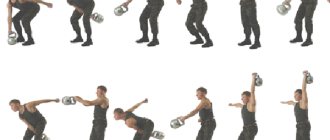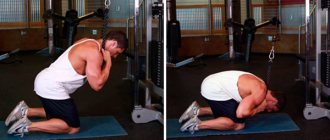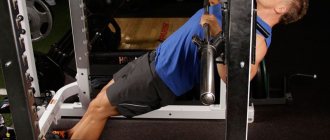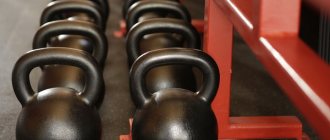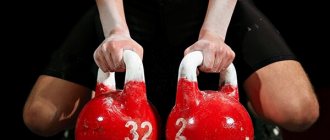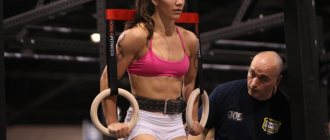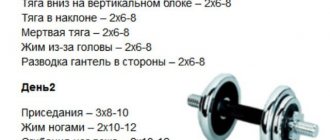The kettlebell snatch is a classic kettlebell exercise. It is performed in competitions along with the push of two weights. Shells of three different weights are used: 16, 24 and 32 kg. Traditionally, kettlebell exercises have been the preserve of weightlifting athletes. However, today kettlebell lifting has regained popularity and training using this equipment is carried out in a variety of disciplines, in particular in CrossFit. Many fitness clubs are equipped with kettlebells; not only men, but also girls show interest in such activities.
Why do the exercise?
The 16 kg kettlebell snatch (pudovki) is included in the list of tests for passing the GTO standards. The technique of performing the exercise in this case remains unchanged. The athlete continuously performs the exercise for 4 minutes, and the judges count the number of repetitions. In particular, to receive a gold GTO badge, a man under 40 years old must snatch a 16 kg projectile 40 times.
Kettlebell lifting began to appear in the 50s of the last century, and has now gained great popularity.
In order to cleanly perform a kettlebell snatch, an athlete must have physical strength, flexibility and the ability to accurately coordinate movements. What muscles work during a snatch? This exercise involves almost all muscle groups and requires enormous physical and energy output. Kettlebell lifting is a powerful tool for developing general physical fitness, strength and coordination.
Including the snatch exercise in your training program leads to the following positive effects:
- Development of strength and growth of the muscles of the back, legs and other muscle groups.
- Strengthen your hands and increase your grip strength.
- Increasing strength endurance and functional capabilities of the body, mastering breathing techniques.
- Training of motor coordination and the ability to tense and relax muscles under control.
- Development of speed indicators.
It is better to start mastering the kettlebell snatch by practicing its component movements. The technique is honed with a minimum weight of 16 kg, and then the weight of the projectile increases. For girls, even 16 kg may be too much weight, so it is worth saying that many fitness clubs have special equipment for women weighing less than 10 kg.
For girls, a 16 kg weight may be too heavy, so it is recommended to use lighter weights.
You can also use regular deadlifts and military presses as preparatory exercises.
Kettlebell lifting involves various variations of exercises. The competitive version of the snatch involves lifting a weight in a standing position with one hand, throwing the apparatus and performing the movement with the other hand without interruption. The same technique is used when passing the GTO standards.
16 kg weights are used when passing the GTO standards.
The starting position may vary: the weight can be placed in the middle in front of the athlete or behind one of the legs. You can also perform jerks while sitting in order to eliminate the work of the leg muscles for one reason or another. And finally, a snatch of two weights can be performed simultaneously or alternately.
Benefits of exercise
Training plays an important role in the physical development of an athlete. If you follow the technique of execution, then it is available not only for men, but also for women. Performing this exercise brings a variety of benefits:
- Strength, elasticity, mobility of ligaments and muscles improves.
- The voluminous and beautiful muscles of the body are harmoniously formed.
- The level of coordination and the ability to correctly combine the action of various muscles, their inclusion in work and relaxation increases.
- Due to increased heart rate and increased breathing, a high load on the cardiorespiratory system is ensured.
- Performing a snatch helps develop strength and general endurance.
- There is an improvement in speed performance.
- High loads during the kettlebell snatch help burn excess fat in the body.
Performing a snatch contributes to the development of strength and general endurance, the formation of beautiful and voluminous muscles
Regular exercise allows you to improve the strength, elasticity, mobility of ligaments and muscles
Due to increased heart rate and increased breathing during the jerk, a high beneficial load on the cardiorespiratory system is provided
Snatch technique
The kettlebell jerk is usually divided into several phases or stages, differing in the mechanics of movement.
Let's list them:
- Starting position. At this stage, the athlete must take the correct starting position, which will allow him to perform the snatch in the best possible way. The weight is placed at the distance of the foot from the legs exactly in the middle. The athlete places his feet shoulder-width apart, bends his legs, and straightens his back. A natural arch remains in the lower back. The projectile is grabbed with the palm from above, the second hand is straight to the side.
- Swing. Due to partial extension of the knees, the weight breaks away and, with a straight arm, like on a swing, is carried between the legs for a subsequent jerk forward.
- Detonation. From the swing, with a powerful short-term effort, the weight bursts forward. This is done at the moment when she has returned to the lowest point (on the line of the feet), due to the simultaneous extension of the legs, lifting on the toes, raising the shoulder and straightening the body. As it descends, the weight has already gained some inertia. After detonation, the projectile picks up speed and flies upward to a dead center. The hand holding the weight remains straight. The point of sticking to this rule is to maintain a rigid frame between the kettlebell, arm, body and legs. The second hand is still moved to the side.
- Podsed. At the moment when the accelerated projectile flies to the highest point and no force is applied to it, the athlete slightly bends his working arm at the elbow and quickly sits down under the weight. At this stage, the bend in the elbow and slightly bent knees are designed to soften the reception of the falling weight as much as possible. The hand turns outward, and the weight describes an arc around it and comes behind the forearm.
- Fixation. The athlete straightens his arm with the weight and straightens his legs. He remains in this position until the judge’s command that the exercise is valid (when passing the GTO test, this is from 0.5 seconds). When training on your own, you can linger at the top point for a second or more if you need to restore your breathing.
- Lowering. To perform subsequent repetitions, the apparatus is not placed on the floor; the movements are performed from a hanging position. The weight can be lowered to the lowest point in two ways - on a straight arm (pendulum) or by gradually bending the arm. The first method is good because it maintains the inertia of the projectile and does not reduce the speed of the exercise. Plus, in a straight position, the arm muscles can rest a little. The second method is designed to reduce the risk of hand injury, however, the muscles are under load all the time.
- Swing to intercept and intercept. In order to change the working hand, the athlete, after the next swing, lifts the weight to a dead point and intercepts the bow. The weight is lowered into the swing again, and jerks begin with the other hand. The technique of movements is completely similar to that described above.
Phases of the jerk: 1 - start, 2 - swing, 3 - undermining, 4 - sitting down, 5 - fixing, 6 - lowering, 7-9 - swing to change hands, 10-13 - performing a jerk with the second hand.
During the snatch, the athlete can be in a low or high stance. In the first case, there is a significant angle in the hip joints, and the weight sweeps just above the floor.
With a high stance, the posture is straighter, the angles at the knees and hips are much smaller, and the projectile is carried at the level of the knees. It is more beneficial from the point of view of saving muscle energy, however, it injures the hands more.
Description of the exercise
This exercise is competitive in kettlebell biathlon. According to the competition rules:
- The arms at the top should be fully straightened
- It is forbidden to place the weight on the floor until the exercise is completed.
- The weight should be lifted to the top in one movement (jerk).
- It is forbidden to press the weight at the top.
- You can only change hands once. If the weight breaks out of your hands, the exercise stops.
- 10 minutes are allotted to complete the exercise.
- Competitions are held with kettlebells weighing 16, 24 and 32 kg.
Nuances and errors
1. To avoid tearing calluses, do not grab the arch with your whole palm. At the bottom you need to lower the bow of the weight onto your fingers, and at the top you need to thread the hand as deep as possible into the bow. So that the bow is on the bone, and not in the palm.
2. You don’t need to let the weight go far away from you when swinging. Otherwise, in the end it will fly not only up, but also back. You need to undermine it so that it flies up and closer to the body. It should also be omitted. That is, you do not need to jerk with a straight arm. The arm should only be straight at the bottom at the beginning of the swing.
3. Do not lean on your leg with your free hand. It is forbidden. It should hang freely from the side and just act as a counterweight.
4. When lowering the weight down, you need to not only tilt your back, but also slightly bend your knees. According to the rules, this is not necessary, but bending your legs will make it easier and more efficient to swing.
5. The swing should occur mainly due to the muscles of the back, buttocks and legs. At the end of the swing, you need to jerk your shoulder upward with the trapezoid to give the weight a flight path. The hand should simply catch the weight at the top. That is, your hands should work as little as possible.
6. To strain your forearms less, you need to screw your hand as deeply as possible into the arch of the weight at the moment the weight flies.
7. Don't lower the weight too low. This will increase the amplitude and you will expend more energy. Lower it as little as possible so that it fits between your legs.
8. When swinging back, you can tear off your toes to remove the center of gravity on the heels and make the swing stronger.
Breath
Among other things, kettlebell lifting involves precise training of breathing techniques. If you do not pay attention to this, the body will not receive enough oxygen for intensive work, which will certainly affect the results. The muscles will quickly tire, and the desired benefits of training will turn out to be harmful.
If you breathe incorrectly, your muscles quickly tire. Strength sports involve exhaling when performing an effort and inhaling during the muscle relaxation phase.
During a jerk, breathing can be done in 2, 3 cycles or more. The best option is 3 cyclic breathing:
- Inhale – lift the weight from the floor.
- Exhalation is the end of the explosion.
- Inhale - squat.
- Exhale – straighten the body and arms.
- Inhale – lower the weight from the top point to chest level.
- Exhale – lowering the projectile until it goes into the backswing.
In the event that there is still not enough oxygen, the athlete can do several breathing cycles at the moment of fixation. This will slow down the speed of the exercise, but will provide an opportunity to restore oxygen reserves. If high-speed and short-term work is necessary, the number of cycles per lift can be reduced.
Having mastered the kettlebell snatch, you can move on to practicing a more complex element - the push. You should also start with 16 kg. Or, if you just love kettlebell lifting, and participating in competitions or receiving a GTO badge is not part of your plans, you can limit yourself to simpler exercises.
Exercises with weights. What's the benefit?
The sports equipment that jitsers love to practice with is the kettlebell. Regardless of where a wrestler lives, in Russia, Moscow, or abroad, if he goes to training in Brazilian jiu-jitsu, he must perform exercises with a kettlebell. Are these exercises really that useful? Let's try to figure it out.
Peculiarities
The kettlebell is one of the oldest sports equipment and one of the few that helps create a load on all muscle groups. Experts believe that kettlebell lifting, in particular exercises with kettlebells, is similar to wrestling.
And this similarity lies in the fact that both a weightlifter and someone who goes to classes in Moscow, for example, in Brazilian jiu-jitsu, learns to breathe correctly when performing exercises.
Each occurs in two stages: tension and relaxation.
A variety of exercises with weights create a load, primarily on the back muscles: upper back, latissimus muscles, etc. There are many exercises and they are varied. For those who practice, we can recommend the following exercises with weights:
- kettlebell jerks;
- swings with a kettlebell;
- Turkish rise.
Benefit
Everyone who visits the BJJ section in Moscow has heard more than once the advice to perform exercises with kettlebells
Is it really that important? What are the benefits of these exercises? Kettlebell snatches are a simple exercise (you can include them in your warm-up), and it is important to follow proper technique when performing them. In the starting position, the weight is between the legs
With a smooth movement it rises to the level of the chest or head and also smoothly falls. When performing jerks, a load is created on all muscle groups and endurance increases.
In the starting position, the weight is between the legs. With a smooth movement it rises to the level of the chest or head and also smoothly falls. When performing jerks, a load is created on all muscle groups and endurance increases.
Kettlebell snatches are a simple exercise (you can include them in your warm-up), and it is important to follow proper technique when performing them. In the starting position, the weight is between the legs. With a smooth movement it rises to the level of the chest or head and also smoothly falls
When performing jerks, a load is created on all muscle groups and endurance increases.
With a smooth movement it rises to the level of the chest or head and also smoothly falls. When performing jerks, a load is created on all muscle groups and endurance increases.
The kettlebell swing is one of the best because it develops grip strength, which is exactly what the jitter needs. Regularly performing this exercise will have a beneficial effect on the cardiovascular system, while it will create a load on the leg muscles and shoulder girdle. However, it is worth remembering that the benefit will only be if you follow the execution technique: your back should be straight at all times.
In a jiu-jitsu club, you may hear from a trainer that one of the best exercises with kettlebells is the so-called Turkish get-up. This exercise also has a complex positive effect on the wrestler’s body. It makes you stronger, strengthens joints and ligaments, and helps develop a sense of balance.
So what is this exercise? The goal is to rise from a lying position, holding the kettlebell in your raised hand.
You need to rise carefully, you cannot bend your arm. Repeat 5 times with one hand and then with the other. To begin with, you can perform it two to three times a week and with light weight.
Gradually the weight can be increased. It is necessary to follow the technique
To begin with, you can perform it two to three times a week and with light weight. Gradually the weight can be increased. It is imperative to follow the technique.
Otherwise, you may get injured.
So, if you want to sign up, pay attention to the kettlebell exercises. They will help you become stronger, more resilient, and will have a beneficial effect on the cardiovascular system, ligaments and joints.
But it is important to follow the execution technique
But it is important to follow the execution technique
Power juggling
In addition to what constitutes kettlebell lifting in its classical manifestation, there is also such a discipline as power juggling. This, one might say, art, historically came from circus performances. Juggling involves throwing projectiles weighing 16 kg and 8 kg (for women) and performing various tricks to the music. One athlete or a whole team can perform.
Power juggling performance programs include up to 30 different types of throws, as well as choreographic elements. In other words, this is not only a sport, but also a spectacular performance. At competitions, not only the technique of performing exercises is taken into account, but also the artistry of the performers.
What is this exercise for?
The kettlebell is a great tool for the true CrossFit athlete and can take your workouts to the next level of intensity. One of the exercises that we highly recommend including in your arsenal is the two-handed kettlebell swing. This is a relatively simple exercise from the point of view of proper technique, and is definitely suitable for those athletes who are just starting to get acquainted with such a discipline as CrossFit. With this exercise, you will develop good explosiveness in the hips and glutes, which will be a huge plus as your fitness level increases and you begin to perform exercises such as sumo deadlifts, front squats and barbell jerks with decent weights.
What muscle groups are used by two-handed kettlebell swings? The main work is done by the quadriceps, hamstrings and gluteal muscles, as well as the lumbar back. The movement is explosive in nature, most of the amplitude of the kettlebell passes through inertia, and only the last 20-30% of the amplitude of the projectile passes through the force of the deltoid muscles, especially the anterior fascicle. The abdominal press and spinal extensors are in static tension throughout the entire exercise. Also, two-handed kettlebell swings develop grip strength well if you perform the exercise with a kettlebell weighing 24 kg or more. This will definitely benefit your hands and forearms; a handshake of steel is guaranteed.
Exercise technique
Despite its apparent simplicity and similarity to a farmer’s walk, walking with weights on outstretched arms has a complex technique. Let's look at exactly how to perform this exercise correctly.
First you need to choose the optimal weight. In the case of an unprepared athlete, it is better to take half-pound and quarter-pound weights, which are available in almost every gym. In rare cases, you can replace them with dumbbells weighing up to 10 kilograms. It is recommended to work with full weight (1 pound weights) no earlier than achieving the following results:
- deadlift 100 kg for 7 reps;
- T-bar row 80 kg for 5 reps.
Why? Everything is very simple. Even with the correct execution of the exercise, due to the change in gravity during penetration, the lumbar region experiences a hellish static load. A powerful deadlift is the only thing that can somehow prepare the lower back and minimize the risk of injury.
» alt=»»>
Phase 1: Picking up a projectile
In order to perform the exercise technically correctly and get benefit from it, and not injure the muscles, it is very important to choose the right equipment for the job. Here's the best way to do it:
- Take 2 shells of the selected weight in your hands.
- Using a shvung, lift them above your head.
- In this position, align your legs - they should be completely straight.
- The lower back is in extreme deflection, the head looks up and forward.
- You need to hold this position for up to 1 minute in order to check the possibility of working with the projectile further.
Phase 2: Execution of penetration
Now let’s take a more specific look at the technique of walking with sports equipment. It looks like this:
- While holding the weights above your head, you need to move your right leg forward as far as possible.
- Next, you should make a springy, shallow lunge.
- After this, you need to bring your back leg to your front leg.
Having fixed the described body position, you need to walk the selected distance
The exercise should be performed moderately and carefully. In case of any deviation of the body or change in the deflection in the lower back, finish the walk ahead of schedule with weights on outstretched arms. As can be seen from the technique, the load on the lumbar region does not disappear, but a change in the center of gravity (taking into account the presence of a load above waist level), the load increases proportionally, and when taking steps, it shifts to the left/right lumbar column
As can be seen from the technique, the load on the lumbar region does not disappear, but a change in the center of gravity (taking into account the presence of a load above waist level), the load increases proportionally, and with steps, it shifts to the left/right lumbar column.
It is better to lower the projectile from a squat, or with a reverse jerk to the bottom. This will allow you to safely, albeit loudly, lower the weights to the bottom without changing the load on the spine.
» alt=»»>
Correct technique
Let's look at how to properly push a kettlebell so as not to injure your back and achieve maximum efficiency of the movement.
Projectile selection phase
It is important to monitor your breathing. Before picking up a projectile, you need to hold your breath, creating pressure in the abdominal muscles for better stabilization
The handle of the weight must be taken in such a way that it rotates freely in your hand. Lifting the weights is done with the back in a deflection. When throwing a weight onto your shoulder, you need to rotate the center of gravity of the projectile so as not to overload the ligaments
This is done by turning the hand with slight supination.
Thrust phase
- Before the push, you need to shift the weight from your chest to your shoulder.
- Bend your legs slightly (no more than 15 degrees at the knees), pushing your hips back.
- Sharply push your body up with your legs (as when jumping), transmitting the impulse through the muscles of the back, not the chest (i.e., align the body as much as possible).
- Using the resulting impulse, sharply push the weight out with your hand in a vertical position.
Pressure and fixation phase
How to push a kettlebell if the initial impulse was not enough to push it out? There is a boost phase for this.
During the boost phase, it is important to monitor your breathing, because... The push-up should be done while half-exhaling. Fixation of the weight occurs when the arm is fully extended in the joint
Fixation of the weight occurs when the arm is fully straightened in the joint.
